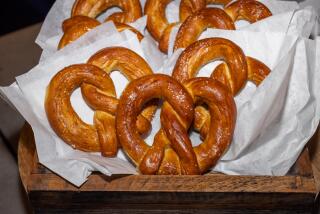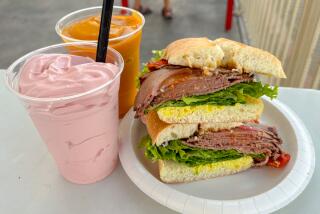Today’s Army Wants You to Like the Food
- Share via
NATICK, Mass. — Jerry Darsch, in his double-breasted suit and you’re-going-to-love-this smile, picked up a piece of lemon pound cake and sang its praises: fresh, light and available in four other flavors.
One problem. The cake is 4 1/2 years old. But this is military food, built to last.
Indeed, the new army cake is tough enough to survive a fall from an airplane and withstand temperatures ranging from 120 to below 60 degrees, said Darsch, a civilian who heads a group of researchers at the Army Soldiers System Command.
Their mission? Improve Army grub.
Meals Ready to Eat, known to some as Meals Rejected by Everyone, have long been the subject of foxhole fury and scorn. As school kids complain about their cafeteria lunches, soldiers condemn their battlefield provisions.
“It’s a soldier’s right to complain about the food,” Darsch said. “If he stopped complaining, it would scare me, because that would mean apathy has set in.”
The team of about 60 scientists, food technologists and nutritionists spend their days in warehouse-sized kitchens and research labs here trying to develop a more succulent chicken, a more pleasing pasta.
The labs, in suburban Boston, began developing new entrees after complaints from Gulf War troops, and they haven’t stopped since.
The Army has replaced the mystery meats and unrecognizable casseroles with such fare as Jamaican pork chops with noodles, chicken strips in salsa, and cheese tortellini and pasta primavera--the military’s first vegetarian meals. Each MRE also has a tiny bottle of Tabasco sauce to jazz things up.
In an effort to combat “menu monotony,” the labs doubled the number of entrees to 24, though not all of them are in the field yet.
Pvt. Joshua Howley, 20, knows all about MRE monotony as he eats his three meals a day while stationed in Bosnia.
The new meals, he said, “were better than the old ones because they were something new.”
“But they got old after a while too. They’re not the greatest, but if you have to eat, they’ll suffice,” said Howley, of Stevensville, Mich.
The pound cake, he said, is the best thing going in the MRE.
Besides new meals, the researchers are trying to develop an easier way for the food to be heated. Last year, it completed a prototype of an updated version of the MRE, which was introduced in 1983.
The Self-Heating Individual meal, or SHIM, is a self-contained package with an entree, a chemical heater and an activating solution. To use, the soldier simply pulls a tab that stimulates the chemical solution. Within 12 to 15 minutes, the meal is hot.
“It’s like its own little stove,” Darsch said.
Army officials have not decided whether to introduce the SHIM.
With the MRE, the soldier must take his entree and place it inside a separate pouch that contains an electrochemical heater. Water then must be added to activate the heater.
But regardless of how the meals are warmed, the soldiers can do little about the take-it-or-leave-it food.
“A soldier in a foxhole doesn’t have the luxury of running over to 7-Eleven,” Darsch said.
More to Read
Sign up for Essential California
The most important California stories and recommendations in your inbox every morning.
You may occasionally receive promotional content from the Los Angeles Times.













